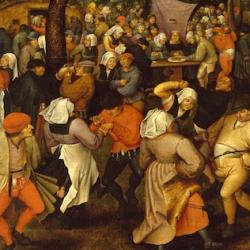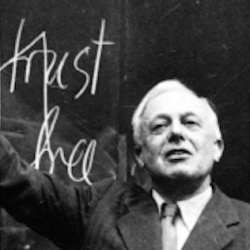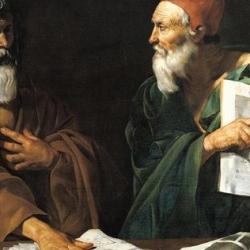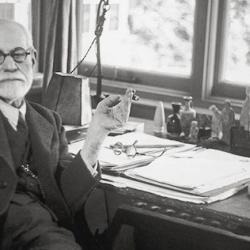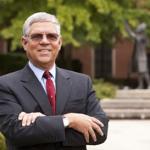When I published some articles on the German-American philosopher Eugen Rosenstock-Huessy (1888-1973) on the web a decade or more ago, I received an email from Norman Fiering, Director and Librarian Emeritus of the John Carter Brown Library at Brown University. A student of Rosenstock-Huessy’s at Dartmouth College during the 1950s, Fiering has been President of the Eugen Rosenstock-Huessy Fund, which maintains Rosenstock-Huessy’s work in print and promotes the study of his work.
Being in Rosenstock-Huessy’s classroom must have been an overwhelming experience. After a long and productive academic career in an Ivy League university surrounded by the best of the best, Fiering still feels the force of his undergraduate teacher. Rosenstock-Huessy was prodigiously learned, as is evident from his wide-ranging published work on philosophy, political and legal history, sociology, the four Gospels, theology, modern science, and, above all, speech. He would arrive in class with a 3 x 5 note card, and lecture for an hour and a half from those few jotted reminders. It was not, however, Rosenstock-Huessy’s learning alone that left a lasting impression. Still today, Fiering describes himself as being under Rosenstock-Huessy’s “spell,” and reminisces about moments during lectures when his teacher seemed to come under the inspiration of some higher power, seemed to “take off.” Many have compared Rosenstock-Huessy to an Old Testament prophet in an effort to capture the reality of a man who, in Fiering’s words, served as a “vessel of the spirit.”
You can hear something of his power as a teacher in the 450 hours of lectures taped by students at
At one point in a lecture on comparative religion, he mentions Jesus’ warning about pearls and swine, quipping “All education is throwing fake pearls before real swine.” That comment is not isolated, and the disdain for the protocols and deadening specializations of modern academic life it expresses is one reason for the obscurity of Rosenstock-Huessy’s work since his death in 1973. Though never a household name, Rosenstock-Huessy was admired during his lifetime by W. H. Auden, who wrote a foreword to one of Rosenstock-Huessy’s books, Lewis Mumford, Harvey Cox, Walter Ong, and Reinhold Niebuhr. Before he left
Others in his circle have continued to rise in reputation. Barth is well established as the greatest Protestant theologian of the last century, Buber has never left the public eye, and Rosenzweig’s work is enjoying a posthumous revival among both Jewish and Christian thinkers, cited regularly by David Goldman in his Asia Times Online columns written under the pseudonym “Spengler.” Yet, Rosenstock-Huessy remains virtually unknown. His historical studies inspired legal historian Harold Berman and prolific American historian Page Smith, but otherwise he has left little mark on contemporary thought. Much of his work remains untranslated into English, and what is available in English is published by the obscure Argo Books of Norwich, Vermont.
In an article on the triangle of Rosenstock-Huessy, his wife Magrit (known as “Gritli”), and Rosenzweig, Michael Zank describes Rosenstock-Huessy as being “by academic standards an oddball.” Were he alive, Rosenstock-Huessy might be happy to return the insult, but he would first acknowledge its truth. I Am an Impure Thinker is the title of one collection of his essays, and he wears the epithet proudly. But his impure oddness is not a pose; it is deliberate, and deeply rooted. One way to get at Rosenstock-Huessy’s oddity, as a man and a thinker, is to say that he was a man of “soul.” He does not speak, teach, or write for fame, money, or to impress. As he says in a chapter on Descartes in his magisterial Out of Revolution (1938), “I am hurt, swayed, shaken, elated, disillusioned, shocked, comforted, and I have to transmit my mental experiences lest I die. . . . By writing a book, a man frees his mind from an overwhelming impression.” He speaks, teaches, and writes for survival, because life presses speech from him as an outpouring of his soul. Understanding what that means takes us to the heart of Rosenstock-Huessy’s work.
Jesus told His disciples to “take up the cross and follow Me,” but Rosenstock-Huessy claims that the cross is not peculiarly Christian but universally human. Every human being lives at the center of what he describes as the “Cross of Reality.” The horizontal axis of the cross is a temporal axis, stretched between the past and the future. The present time is always a complex combination of past and future, and the conflicting and equally legitimate demands of tradition and innovation create tensions, strife, and pain. The vertical axis of the Cross of Reality is a spatial axis. Contrary to Cartesian or Newtonian conceptions, space is not “pure extension” or an empty vacuum, but dual, divided between the space of my inner life and the space of the world outside. Socially, too, space is divided between one’s in-group and all out-groups. Like the temporal axis, the spatial axis brings conflicting yet legitimate demands. I must be loyal to my in-group, but I have equally pressing obligations toward those outside. Trying to meet these obligations wounds us and tears us in two. To live is to be rent in four directions, by the past and the future, by the inside and the outside.
It’s possible to relieve the tension and pain of life by amputating one or the other pole of the Cross. We can renounce the future and enclose ourselves, as the Amish do in central
Rosenstock-Huessy’s life-long obsession with speech becomes clearer within this account of human experience. Speech is our primary means for living out this cruciform existence and integrating its multiform demands. Through the speech of teaching, the past is relayed to a new generation, which is in turn called to listen in order to create a human future. At the same time, the old must also listen to the yet-inarticulate shouts of the young, lest the next generation be dominated exclusively by the spirit of sons and not by the double spirit of fathers and sons. From within our in-group, we must speak to those outside, in hopes that they will come to understand our language, and if we are to escape war, our inner group must be willing to listen to and learn from those outside our walls.
Time is as much an obsession for Rosenstock-Huessy as speech. He challenges the modern tendency to flatten time into a mechanical “ticking of the clock,” urging instead that time is multi-dimensional. The regimented time of a factory and its shifts is not the same as the lyrical time of contemplating a sunset or the play-time of sports. Nor is time merely a uniform passage of moments. Time is articulated into units, what Rosenstock-Huessy calls “bodies of time,” by human action and speech. This is an important aspect of the temporal axis of the Cross of Reality. Living wisely in time means knowing when a trend or habit of the past has become decadent and needs to be buried so that a new thing can begin. We create the fissure between past and future by declaring that something is over and done. Peace treaties put war into the past and initiate a future of peace, while fashion designers, moviemakers, and marketers increase sales by dividing the time of style into “old-fashioned” and “fresh.” At a broader level, history has seams, moments when one epoch is brought to a close and a new epoch initiated.
Against this background, we can understand what Rosenstock-Huessy means by “soul.” Soul is not, he insists against some philosophers, identical with the mind. Mind is inherently conservative, oriented to the past pole of the Cross of Reality. The brain, Rosenstock-Huessy likes to point out, is the sole organ in the human body that does not reproduce cells. He also appeals to the experience of adolescence to show that the mind is not the leader of the body but frequently its lowly servant. A young man surging with hormones is not driven by thoughts of sex. His body is in charge. Thought assists the young man’s agitated body by giving him schemes and plots to fulfill his desires.
Soul is not mind also because, for Rosenstock, the mind is timeless while the soul is thoroughly embedded in time. Contrary to much of the Christian tradition, and particularly to popular piety, Rosenstock-Huessy insists that the soul is not fuzzily “supernatural.” The term “soul” applies to “everything about men and women that has to do with the total duration and unity of their existence,” including “destiny, profession, marriage, children, honor, fame, disappointment, suffering, sacrifice, personal names.” Soul contrasts not only with mind, but with body and spirit. Bodily needs arise and are met within a brief span of life. We get hungry, and relieve our hunger by working so that we can buy food. Desire masters us, and we relieve ourselves in sexual encounters. These bodily needs, even when we fulfill them repeatedly over a lifetime, do not constitute a unified life-story: “No matter how many daily wages are added together, they will not equal the course of a life; no matter how many sexual acts, they will not equal a marriage.”
Concerns of the “spirit,” by contrast, “go above and beyond the time limits of souls.” Spirit unites souls together, whether in space or time. Spirit is what unites fathers to sons, and what unites my family to another: “We should understand all matters of the spirit as an inherited succession of souls.” Spirit is a “structure that reaches out” beyond the individual, to which an individual must yield if his life is going to transcend the material demands of the body. Spirit can grip a single person, but it does so “only in order to reach others through him.”
Body and spirit differ in their time-spans. Bodily time-spans are short, and the time-spans of the spirit are inter-generational, and ultimately, in Rosenstock-Huessy’s Christian framework, the time-span of the Spirit stretches from creation to eschaton, forming human history into a single story. Soul is in between, uniting the time-span of the individual life. The Spirit is changeless, working to unite changing humanity and a changing world. But the soul that responds to the Spirit “must remain open to change. Obedience to the appeals of the spirit is the life of the soul.”
On Rosenstock-Huessy’s account, then, it is clear that “soul” is not “Ego.” Soul is inherently responsive, not the self-standing “I” of Descartes. Souls don’t exist in an empty landscape, but are formed in encounters with others. Souls are called forth by names, and the life of the soul has a grammatical structure. Souls are awakened first by being addressed from the outside, in the second person, as a “thou.” Only over time do souls come to speak of themselves in the first person. In the world of human souls the grammatical first person is not first in human development. Psychologically and socially, the first person is the grammatical second, the “you” addressed from the moment of birth when parents say, “You are John” or “You are Mary.” To be a soul is to say, in Rosenstock-Huessy’s counter-Cartesian formula, respondeo, etsi mutabor – “I respond, although I shall be changed.”
Speech shapes the soul, and the soul also comes to expression in speech. For Rosenstock-Huessy, the speech of the soul is not idle chit-chat or detached speculation. Speech is proclamation, command, memory, song, poetry, self-committing oaths in which the speaker is accountable for his utterance. In part, these forms of speech are squeezed out by life on the Cross, as the pressures of the Cross force speech from our souls, lest the Cross tear us apart. In part, these forms of speech are the soul’s means for achieving integrated life when all the forces of the world are tearing it in shreds. We speak in response in the agony of our suffering in order to find common life with other souls, in order to cast a line in hope to the future and to the outside.
Above all, the soul is the human capacity to survive death. A soul is born in being named and addressed, but takes shape and comes to fruition in the experience of suffering on the Cross of Reality. A soul, Rosenstock-Huessy says, “is born through the growing pains of suffering in action.” The soul is that in human beings which enables us to suffer the partial deaths inherent in life, and to rise again to a new future. Soul enables the single man to die to singleness and be reborn as a husband; it’s the power Father Zossima talks of that enables a woman to lose a child and yet love the remaining children; it’s the power that makes it possible for a student to leave playtime behind and enter the world of work and politics; it’s what makes it possible for a woman to retire from active life without bitterness or desperation. The Christian soul in particular is the soul that believes the Christian gospel, which announces that the deaths of the Cross are always gateways to new life. As it knits together the deaths and rebirths that constitute a life, soul molds what could be a fragmented life into a unified body of time.
In this last sense particularly, Rosenstock-Huessy is a man of soul, for his life was marked by periodic deaths and resurrections. As a young man, he was a rising academic star prior to World War I, but initially refused to return to academic life after the war. In a letter written in 1946, he describes the post-war German university as a place of dead works, and says that returning to academic would have been a sin against the Holy Spirit. Instead, he took a position with Daimler-Benz as editor of a company newspaper, which led to a life-long interest in industry and labor. When Hitler was elected, he discerned the direction of German culture and politics, and in 1933 he left
By the same token, Rosenstock-Huessy would not be surprised that his work has fallen into comparative obscurity. “A seed must fall into the ground and die,” Jesus said, “if it will bear fruit.” Rosenstock-Huessy believed that this described a universal principle of history: Human beings bear fruit only in dying, and creative speech bears fruit only after germinating in the ground for a time. He would not be surprised that his work has been laid in an unmarked grave. But he doubtless died in hope that the stone would someday be removed.
Rosenstock-Huessy’s work has never found a more welcome intellectual environment that it does today. He anticipated a number of “postmodern” developments. Already in the middle of the twentieth century, he was predicting that the world was entering a paradoxical age of simultaneous globalization and re-tribalization. In an essay on “The Metabolism of Science,” he deconstructs a book title, a set of lab notes, and Faraday’s notebooks with the serious glee of a Teutonic Derrida. He said “Farewell to Descartes” long before Descartes-bashing became the popular sport it is today. Theologians who work, in Fergus Kerr’s phrase, “after Wittgenstein,” would find the Sprachdenker Rosenstock-Huessy a useful interlocutor, as would postliberals who follow George Lindbeck’s “cultural-linguistic” model of doctrine. Rosenstock-Huessy’s historical work is attentive to culture, styles, fashions, festivities, calendars, play, in ways that anticipate Robert Darnton, John Bossy, Natali Zemon Davis, and Keith Thomas.
In the 1960s the American church historian Martin Marty said something along the lines of “Rosenstock-Huessy was ahead of his time. He still is.” That same judgment applies forty years on. But perhaps, finally, we are coming close to catching up, and perhaps his work is ready to overcome not only the author’s death but to come from the shadowy valley of academic indifference. Perhaps Rosenstock-Huessy will finally prove to be the man of soul that his former students have long recognized him to be.
As a man of soul, however, Rosenstock-Huessy would not want his work to be offered as another set of theoretical proposals. He spoke from the center of the Cross, spoke with all the uncanny power of a man acquainted with death and new life, spoke in hope that his words would awaken other souls. His voluminous writings will have the effect he wanted only if they inspire singing and dancing, commands and attentive listening, courageous action and exultant praise.






